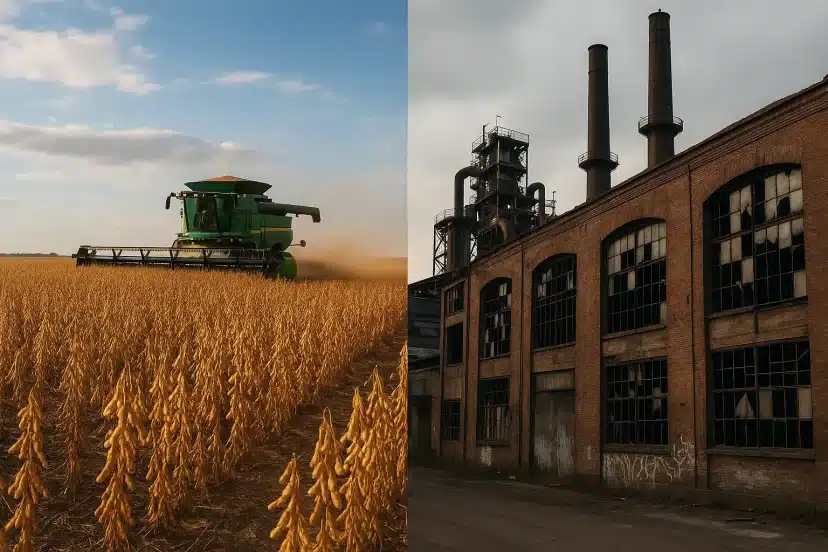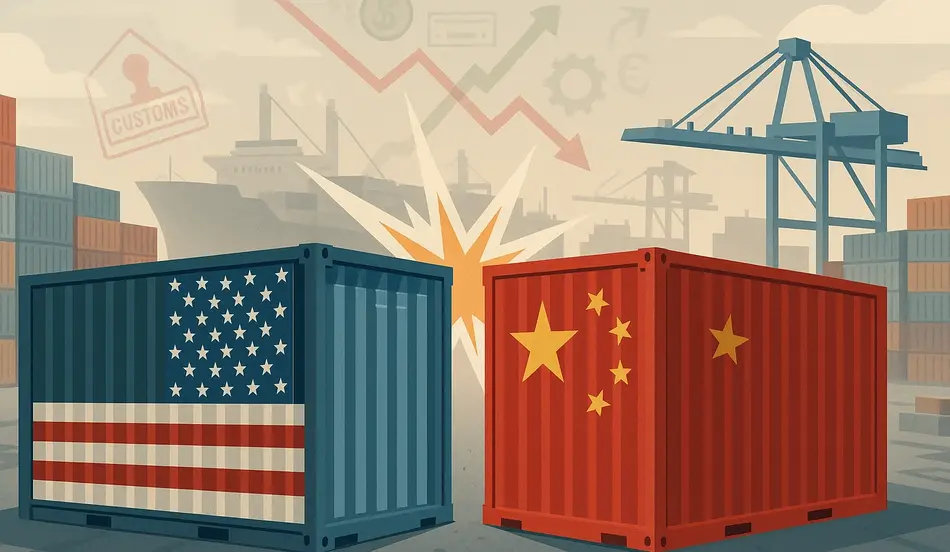US–China Trade War Impact 2025 is still being felt across key sectors of the economy especially in agriculture. The seeds of this shift were planted back in 2018, when the Trump administration imposed tariffs on hundreds of billions of dollars of Chinese goods. Beijing retaliated with its own tariffs, hitting American agriculture particularly hard. Soybeans — once the crown jewel of US farm exports were slapped with heavy duties, cutting deep into farm incomes.
Although China’s demand rebounded in the years that followed, the damage had been done. Beijing began systematically searching for alternative suppliers, particularly in South America. Brazil, with its vast farmlands and competitive costs, became the prime candidate.
Fast forward to 2023: Brazil exported a record $60 billion in agricultural products to China, overtaking the US as Beijing’s top food supplier. Now, with Cofco’s new terminal at Santos, China is locking in this relationship for decades to come.
“Brazil is no longer just a backup plan for China — it’s the main plan,” said one agricultural analyst. “That’s a nightmare scenario for American farmers.”
Table of Contents
Why Santos Matters
The Port of Santos is the beating heart of Brazil’s agricultural economy. In 2024, it handled 180 million tons of cargo, more than half of it agricultural commodities like soybeans, sugar, and corn. Already stretched to capacity — over 90% of bulk agricultural facilities are in use — the port has been struggling to keep up with demand.
That bottleneck has kept Brazil from fully capitalizing on China’s hunger for grain. Cofco’s project is designed to change that. By expanding its export volume from 4.5 million to 14 million tons per year, the new terminal will cement Brazil’s position as China’s go-to supplier.
It also fits neatly into Beijing’s Belt and Road Initiative, its global infrastructure strategy. China is already financing railroads across Brazil’s agricultural belt and even exploring a 3,000-mile transcontinental railway to connect Brazil’s farms to a $3.5 billion Chinese-funded megaport in Peru. The goal: slash shipping times to Asia by up to 10 days and reduce dependence on US-controlled Pacific routes.
Hire Talent to Stay Competitive in a Changing Global Market
Post your job on WhatJobs and connect with supply chain experts, trade analysts, and strategists who can help your business adapt to tariff-driven transformations.
Post a Job Now →The US Farmer’s Dilemma: US–China Trade War Impact 2025
For America’s farmers, the trend is deeply worrying. China has been the single most important buyer of US soybeans, pork, and other crops for decades. Losing that market would be devastating.
According to USDA research, the first trade war cost US agriculture over $27 billion in lost exports. Now, with Trump back in office and pressing Beijing to quadruple US soybean purchases, the numbers don’t add up.
Export data from April already shows China scaling back US soybean and pork purchases. If Cofco’s expanded capacity comes online in 2025, analysts say American farmers could see a permanent shift in demand away from the US
“Trump is asking China to buy more soybeans at the very moment China is building infrastructure to buy fewer,” one trade expert noted. “That’s the contradiction at the heart of US policy.”
Brazil: Winner or Loser?
On paper, Brazil looks like the big winner. Its farmers are poised to cash in as China ramps up imports. Soybeans alone generated over $50 billion in export revenue in 2023, and Cofco’s terminal could push that number higher.
But beneath the surface, the story is more complicated. Brazil is undergoing one of the fastest processes of de-industrialization in the world. As the country exports raw agricultural goods to China, it imports manufactured goods in return — from electronics to machinery — hollowing out its domestic industries.
“Brazil risks becoming a commodities appendage of China,” said a São Paulo economist. “Yes, exports rise, but factories close, jobs vanish, and long-term development stalls.”
This dual reality — booming farms, shrinking factories — has sparked debate inside Brazil about whether the China relationship is sustainable.

US Tariffs and Brazilian Politics
The situation is further complicated by US politics. In 2025, Trump imposed a 50% tariff on many Brazilian goods, one of the world’s steepest. The move was partly economic and partly political: critics say it was designed to pressure Brazil’s government over the ongoing trial of former right-wing president Jair Bolsonaro, a Trump ally accused of plotting a coup in 2022.
Brasília has made it clear it won’t interfere in Bolsonaro’s case. But the tariffs could deepen Brazil’s pivot toward China.
“The message from Washington is clear: we’re not a reliable partner,” one Brazilian diplomat said. “And China is ready to step in.”
A Shifting Global Trade Order
The Cofco project is more than a port expansion — it’s a symbol of shifting global power. For decades, US farmers relied on China’s demand as a stabilizing force. Now, that foundation is eroding.
Meanwhile, China is not only securing its food supply but also embedding itself deeply into Latin America’s infrastructure. The Santos terminal, new railways, and the Peru megaport form part of a strategic corridor that will give Beijing more control over how and where it sources food.
The US, by contrast, risks losing both market share and influence. If China can source most of its soybeans and grains from Brazil, Washington’s leverage in trade negotiations diminishes.
What Comes Next
For US farmers, the outlook is bleak unless Washington can find new markets or repair relations with Beijing. For Brazil, the short-term windfall may come at the cost of long-term industrial decline. And for China, Cofco’s port expansion is just one piece of a much larger puzzle: building a global supply chain that bypasses US pressure.
The story of Santos is ultimately a story about power — who controls the flow of food, and by extension, the future of global trade.
FAQs
1. Why is China building an export terminal in Brazil?
To secure long-term access to Brazil’s agricultural goods and reduce reliance on US imports. The project also fits into China’s Belt and Road strategy of controlling key global trade routes.
2. How will this impact US farmers?
It could significantly cut into their market share in soybeans and pork, leading to billions in lost export revenue. US farmers are already seeing reduced Chinese purchases in 2025.
3. What are the risks for Brazil?
While farm exports will rise, Brazil’s manufacturing sector is shrinking. Critics warn the country is becoming overdependent on China and vulnerable to de-industrialization.
4. How do US tariffs affect the situation?
The Trump administration’s 50% tariffs on Brazilian goods are pushing Brazil closer to China, making it harder for Washington to maintain influence in Latin America.




